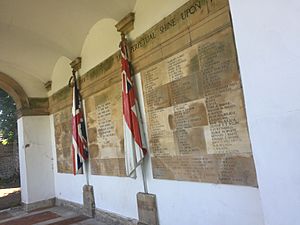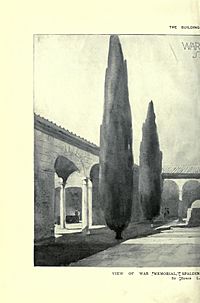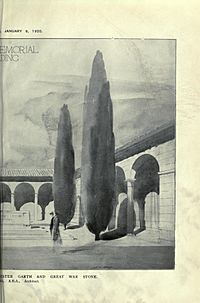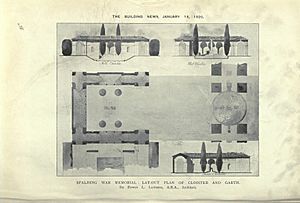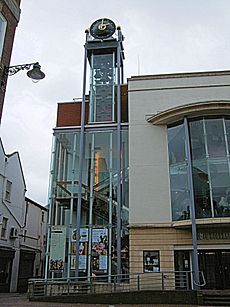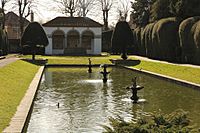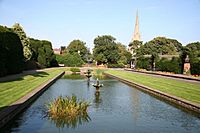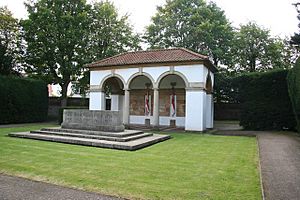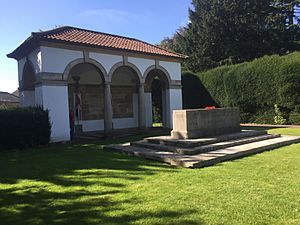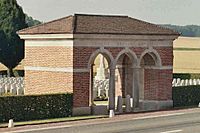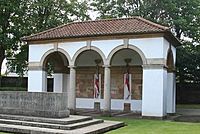Spalding War Memorial facts for kids
Quick facts for kids Spalding War Memorial |
|
|---|---|
| United Kingdom | |
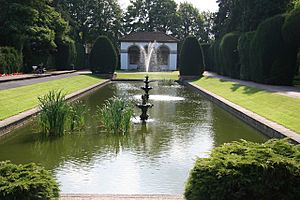 |
|
| For servicemen from Spalding killed in the First World War | |
| Unveiled | 9 June 1922 |
| Location | 52°47′0.5″N 00°08′57.4″W / 52.783472°N 0.149278°W Ayscoughfee Hall Gardens, Spalding, Lincolnshire
|
| Designed by | Sir Edwin Lutyens |
|
IN LOVE AND HONOUR / OF THOSE WHO / GAVE THEIR LIVES / FOR THEIR COUNTRY / IN / THE YEARS OF WAR / MCMXIV – MCMXIX / THIS MEMORIAL IS RAISED / IN THEIR HOME / BY THE MEN AND WOMEN / OF / SPALDING
|
|
|
Listed Building – Grade I
|
|
| Official name | Spalding War Memorial |
| Designated | 20 November 1975 |
| Reference no. | 1064002 |
The Spalding War Memorial is a special place in the gardens of Ayscoughfee Hall in Spalding, England. It was built to remember the soldiers from Spalding who died in the First World War. A famous architect named Sir Edwin Lutyens designed it.
The idea for this memorial started in 1918. A woman named Barbara McLaren suggested it. Her husband, Francis McLaren, was a Member of Parliament for the town. He sadly died in a flying accident during the war. Barbara asked Lutyens to design a grand memorial. It was meant to be a special covered walkway (a cloister) around a circular pond with a cross in the middle. The memorial was planned for the beautiful gardens of Ayscoughfee Hall.
When Barbara McLaren shared her idea with the local council, people in the town discussed it a lot. Many different ideas for a memorial were suggested. After a public meeting and a vote in 1919, a smaller version of Barbara's plan was chosen. They also decided to add a clock to the town's corn exchange building.
The memorial cost £3,500 to build. Barbara and her father-in-law each gave £1,000. Her brother-in-law donated two special stone flags. The rest of the money came from people in the town who wanted to help. This fundraising took until 1922. The memorial has a brick building (a pavilion) and a large stone called the Stone of Remembrance. Both are at the start of a long, calm pool of water. This pool used to be part of an old canal from the 1700s. The memorial was officially opened on June 9, 1922.
Sir Edwin Lutyens later used ideas from this pavilion for buildings in war cemeteries in France. However, this memorial's design is quite unique among his other war memorials. Today, Spalding War Memorial is a Grade I listed building. This means it's a very important historical site.
Contents
Why War Memorials Were Built
After the First World War (1914–1918), war memorials became very common in towns across Britain. Nearly one million British men died in the war. So, monuments were put up in almost every town and village. These memorials helped people remember those who were lost.
The memorial in Spalding was designed by Sir Edwin Lutyens. He was already famous for designing large country homes for wealthy families. From 1917 onwards, Lutyens spent a lot of his time designing memorials for war dead. He worked with the Commonwealth War Graves Commission and also designed memorials through his own company. Spalding was one of his first projects for a war memorial.
The idea for the Spalding memorial came from Barbara McLaren. She was the wife of Francis McLaren, who was a Member of Parliament for Spalding. He was an officer in the Royal Flying Corps and died in a flying accident in 1917. Barbara was also the niece of Gertrude Jekyll, a famous garden designer who had worked with Lutyens many times. Lutyens had designed the McLarens' house in London. After Francis died, Lutyens also designed his gravestone and later the war memorial in the same village.
How the Memorial Was Chosen
Barbara McLaren asked Lutyens to design a memorial for the gardens of Ayscoughfee Hall. The local council had bought this hall in 1897 to celebrate Queen Victoria's 60 years as queen. Lutyens suggested a U-shaped covered walkway. It would protect a Stone of Remembrance in front of a round lily pond. A cross would stand in the middle of the pond. Barbara wanted families to be able to add their own messages. But this would have needed too much space. She also made sure her husband would not get a special memorial. He would be remembered just like all the other soldiers.
Barbara McLaren presented her idea to the council in January 1918. After the war ended, her plan became public and caused a lot of discussion. People wrote letters to the local newspaper about it. Many other ideas were suggested. Some wanted a simple clock on the town's corn exchange building. Others wanted to turn Ayscoughfee Hall into a youth center.
The youth center idea and Lutyens's plan became the most popular. Details of both were printed in the local newspaper. The council held a public meeting on August 1, 1919. About 300 people came. Supporters of the two main ideas, plus the clock idea, each had fifteen minutes to explain their plans. Other ideas were also suggested, like a tall monument (a cenotaph) in the market square.
The meeting ended with a decision to hold a public vote. This vote happened on August 23. People could choose from seven options:
- A changed version of the McLaren–Lutyens plan with a clock on the corn exchange.
- The McLaren–Lutyens plan as it was.
- A tall monument in the market square and a memorial clock.
- The McLaren–Lutyens plan and a youth center in Ayscoughfee Hall.
- A tall monument in the market square.
- Money for war widows (instead of a monument).
- The youth center by itself.
The changed McLaren–Lutyens plan won clearly with 459 votes. The original plan was second with 286 votes. The idea for a monument and clock was the only other option with more than 200 votes.
In September 1919, a committee was formed to raise money and build the memorial. The total cost was £3,500. Barbara McLaren and her father-in-law, Charles McLaren, 1st Baron Aberconway, each gave £1,000. Her brother-in-law, Henry McLaren, 2nd Baron Aberconway, donated the stone flags. The rest of the money was raised from public donations, which took until 1922.
The clock and a set of 23 bells (a carillon) were put on the corn exchange in the town center in 1922. This was the same year Lutyens's memorial was finished. Three of the bells had names of soldiers from the war. Other bells had names of people involved in the memorial project. The corn exchange building was pulled down in 1972. A new arts center, the South Holland Centre, was built in its place. The clock and bells were moved to a tower on its roof. In 1998, after the South Holland Centre was updated, a new glass tower was built for the cleaned bells. On Armistice Day in 1998, a special plaque was put on the South Holland Centre. It explains the importance of the clock tower.
Memorial History and Design
Lutyens's memorial was built in the Ayscoughfee Hall Gardens. It was placed at the south end of the formal gardens. It replaced an older tower from the 1800s called the "Owl Tower." The memorial was officially opened on June 9, 1922. General Sir Ian Hamilton led the ceremony. Reverend Alfred Jarvis dedicated it. Barbara McLaren and her family also attended.
Several important people gave speeches. Reverend Jarvis spoke about the soldiers who died among the poppies. General Hamilton talked about the sad results of the war. He said that Europe was full of hatred. He told the crowd, "If you want to end war, you must end hatred." He believed that by working for peace, they would honor those who died. After the speeches, a bugler played "Last Post." The crowd sang the national anthem. Then, important people, including Barbara McLaren and her sons, placed flowers around the Stone of Remembrance.
In 2014, before Remembrance Sunday, the names of 24 more soldiers from the First World War were added to the memorial. This happened after research by a local group. The memorial is now looked after by the South Holland District Council.
What Does the Memorial Look Like?
Spalding's war memorial has a brick building called a pavilion. It has a sloped roof made of red tiles. The floor inside is made of red bricks in a special pattern. The side of the pavilion facing the pool has three stone arches. There is also an arch on each side wall.
The back wall has two painted stone flags: the Union Flag and the White Ensign. It also has three panels. On these panels are the names of over 200 soldiers from Spalding who died in the First World War. The middle panel has a special message: "IN LOVE AND HONOUR OF THOSE WHO GAVE THEIR LIVES FOR THEIR COUNTRY IN THE YEARS OF WAR MCMXIV – MCMXIX / THIS MEMORIAL IS RAISED IN THEIR HOME BY THE MEN AND WOMEN OF SPALDING." Inside the pavilion, there is another message: "ETERNAL REST GRANT TO THEM O LORD AND LET LIGHT PERPETUAL SHINE UPON THEM." A separate stone remembers Francis McLaren. It says he was a Member of Parliament for Spalding and died serving his country at age 31.
A large stone called the Stone of Remembrance stands in front of the pavilion. It has the words "THEIR NAME LIVETH FOR EVERMORE" carved on it. The dates of both World Wars are also on it. The dates for the Second World War were added later. This stone is made from one piece of rock. It is about 12 feet (3.7 meters) long and has no other decorations.
A long pool of water stretches out from the memorial. This pool was originally a canal from the 1700s. Lutyens changed it into a calm reflecting pool, like those in Italian gardens. Three small fountains were added later. Yew hedges surround the pavilion and the pool. On the east side, iron gates lead to a peace garden, which was added in 1994. The view of the pavilion at the head of the pool looks a bit like the gardens at Bodnant Garden in Wales. This was Francis McLaren's childhood home.
The Memorial's Importance
By the time the Spalding memorial was opened in 1922, Lutyens had already been working on war memorials for several years. He designed The Cenotaph in London, which became the main place for national Remembrance Sunday events. He also designed the Stone of Remembrance used in war cemeteries. His work led to many commissions for war memorials across Britain and other countries.
Lutyens's first design for Spalding was shown in a war memorials exhibition in London in 1919. Historians say the Spalding design was "an exceptional departure" from Lutyens's usual style. He didn't use this exact design for other war memorials. However, the pavilion influenced his later designs for buildings in war cemeteries in France. For example, the entrance shelter at Anneux British Cemetery looks very similar.
Over time, the Spalding memorial became less well-known. It wasn't written about much until a book called Lutyens and the Great War came out in 2008. Barbara McLaren later married Bernard Freyberg, 1st Baron Freyberg. Some people think this might have led to Lutyens designing another memorial in London.
The memorial was first listed as a Grade II listed building in 1975. In 2015, as part of the 100-year anniversary of the First World War, Lutyens's war memorials were recognized as a "national collection." All 44 of his memorials in England had their historical status reviewed. As a result, Spalding War Memorial was upgraded to Grade I. This means it is considered a building of exceptional interest. Ayscoughfee Hall itself is also Grade I listed. The gardens are listed as Grade II on the Register of Historic Parks and Gardens of Special Historic Interest in England.


